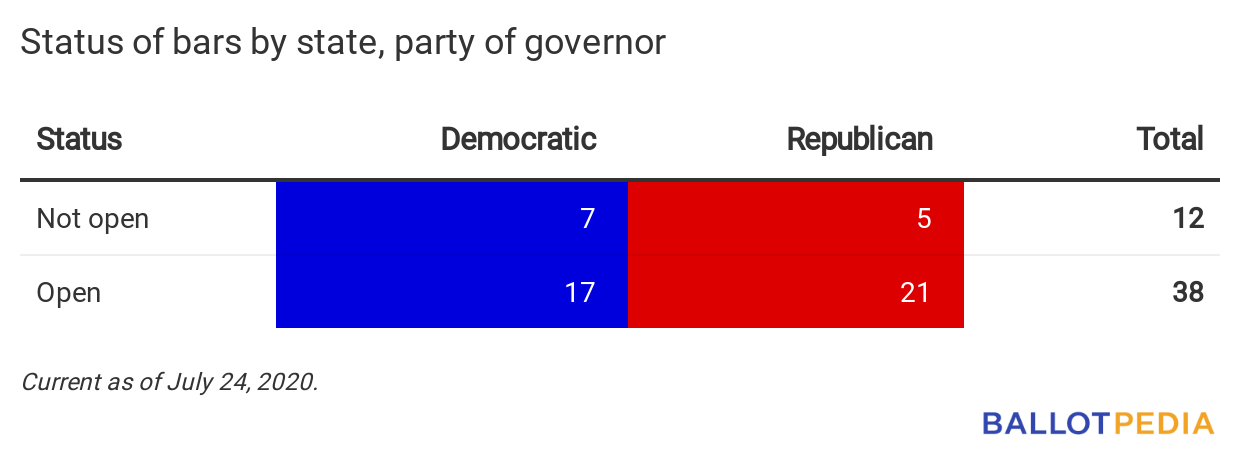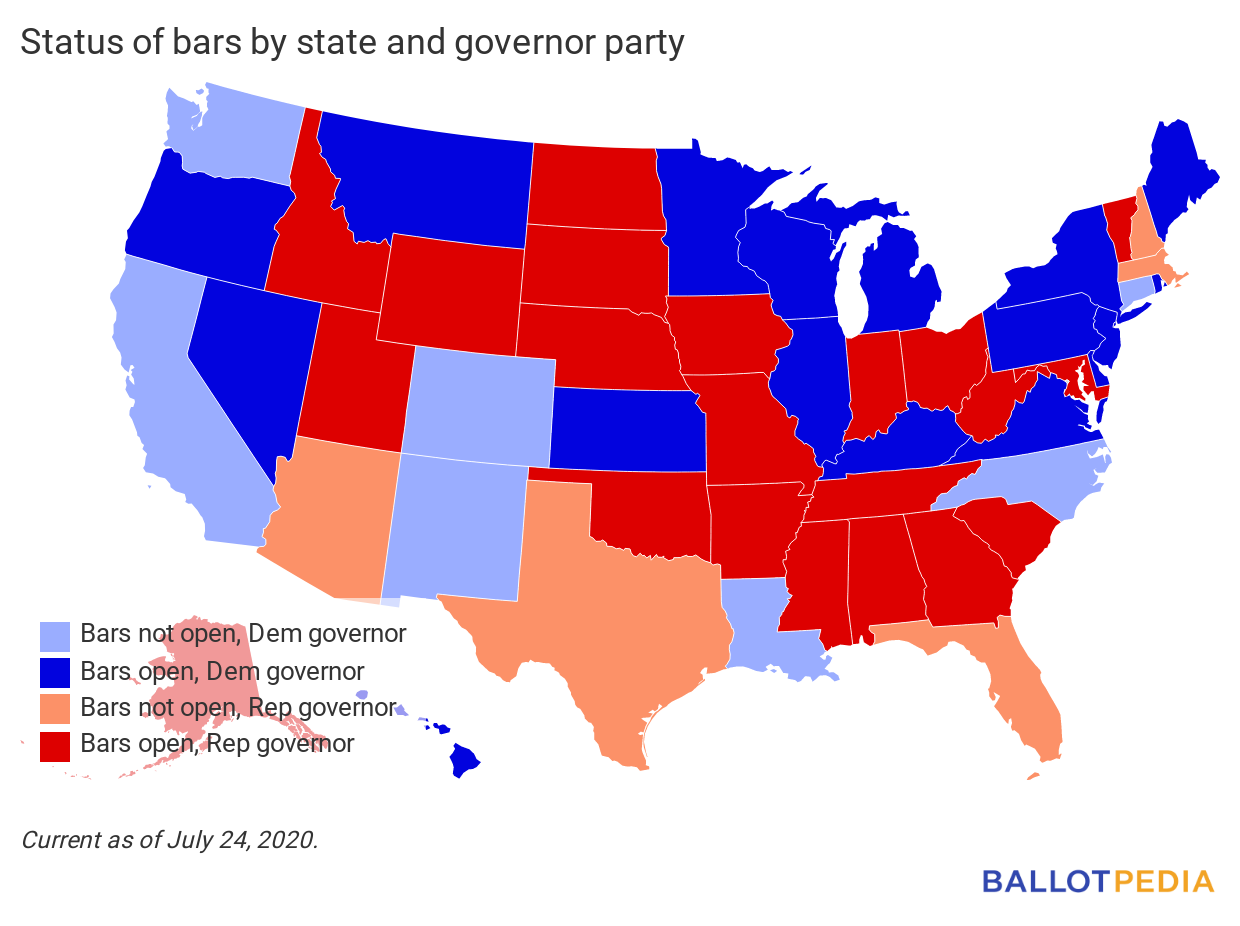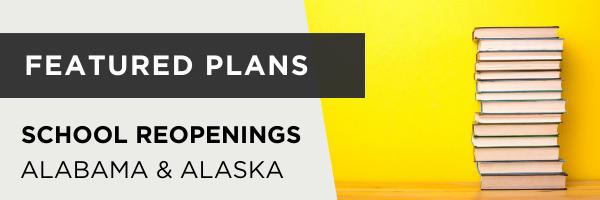Each day, we:
- Track the status of reopening in all 50 states.
- Compare the status of one industry or activity across the country.
- Answer key questions about state school reopening plans.
- Give you the latest stories on other reopening plans and ideas.
Want to know what happened yesterday? Click here.
The next 72 hours
What is changing in the next 72 hours?
- Indiana (Republican trifecta): On July 22, Gov. Eric Holcomb (R) announced that anyone 8 or older would be required to wear a face mask in indoor public spaces, commercial businesses, transportation services, or in outdoor public spaces where social distancing is not possible. Students in third grade or higher, along with faculty and staff, must wear face masks in school. The requirement takes effect on July 27.
Since our last edition
What is open in each state? For a continually updated article on reopening status in all 50 states, click here. For our last edition, click here.
- Arizona (Republican trifecta): Gov. Doug Ducey (R) ordered bars, gyms, and water parks to remain closed for two additional weeks. Ducey issued an executive order closing those businesses on June 29 that was set to expire July 27. Ducey also ordered public schools to reopen for on-site learning on Aug. 17 for students who have nowhere else to go. Superintendent Kathy Hoffman clarified that the order meant each school district must open at least one site for students to go, but did not have to open every school or require every teacher to work in-person.
- Iowa (Republican trifecta): Gov. Kim Reynolds (R) extended the state’s public health emergency for 30 days to Aug. 23. Reynolds did not add any new restrictions as part of the extension.
- Louisiana (divided government): Gov. John Bel Edwards (D) extended Phase Two of the state’s reopening plan through Aug. 7, including the statewide mask mandate.
- New Jersey (Democratic trifecta): The state released guidance regarding a remote-only learning option for public school students. During the 2020-2021 school year, parents will be able to enroll their children in a fully online learning schedule.
- New Mexico (Democratic trifecta): Gov. Michelle Lujan Grisham (D) announced schools will not be able to open for in-person instruction until after Sept. 7. Individual school districts decide when classes begin in New Mexico, so there is no statewide reopening date.
- Ohio (Republican trifecta): A statewide mask mandate went into effect. Gov. Mike DeWine (R) announced the mandate on July 22. DeWine previously imposed mask requirements on counties with high numbers of COVID-19 cases. The mandate will require all individuals 10 years and older to wear a mask indoors and outdoors if social distancing isn’t possible.
- Oregon (Democratic trifecta): Effective July 24, the state’s mask requirement applies to every person five years of age or older. Bars and restaurants also have to stop serving customers at 10 p.m. every night. The state also released draft guidance for early learning and childcare programs.
- Pennsylvania (divided government): The state added Missouri and Wyoming to its 14-day self-quarantine travel advisory list. Travelers from 20 states are now advised to self-quarantine when visiting or returning to Pennsylvania.
- Vermont (divided government): Gov. Phil Scott (R) issued an executive order requiring people older than the age of two to wear masks in public places. The mandate will take effect on Aug. 1.
- Washington (Democratic trifecta): Gov. Jay Inslee (D) announced new activity restrictions, effective July 30. Weddings and funerals will be limited to 20% capacity (with a maximum of 30 people) and event receptions will be prohibited. In Phase 3 counties, restaurants will be limited to 50% capacity, members of the same table will have to be from the same family, and the maximum number of people at a table will decrease to five. Bars will be closed for indoor service (outdoor service will still be permitted). Gym occupancy will be reduced to 25% in Phase 3 (or five people in Phase 2). Indoor entertainment venues (like bowling alleys and arcades) will not be allowed to open in Phase 3, while movie theaters will be limited to 25% capacity. Secretary of Health John Wiesman also said he would expand the state’s mask order to require face coverings in all common spaces, effective July 25. Such spaces will include elevators, hallways, university housing, hotels, and nursing homes.
Tracking industries: Bars
All 50 states are reopening in some way. Here, we give the status of one industry or activity across the states. Today’s question: in which states may you go out for a drink?
We last looked at bars in the June 29th edition of the newsletter. Since then, three states—California, Colorado, and Louisiana—have closed bars. Two states, Maryland and New York, have opened bars.
 
|

This is an in-depth summary of two state plans to reopen public K-12 schools for the 2020-2021 school year.
Alabama’s Roadmap for Reopening
The Alabama Department of Education (ADOE) released public school reopening guidance on June 26. Superintendent Erick Macey said the guidelines were not mandated and that school districts would create their own individualized plans.
On March 13, Gov. Kay Ivey (R) ordered public schools to close from March 18 through April 5. Ivey closed public schools for the remainder of the school year on March 26. On May 21, Ivey announced that public schools could reopen beginning June 1 if they followed social distancing and sanitation guidelines.
According to ADOE’s checklist and guidance for school-sponsored activities, public schools will reopen for the 2020-2021 academic year in August. School districts have the authority to set their exact start date.
Context
Alabama is a Republican trifecta. The governor is a Republican, and Republicans hold majorities in both chambers of the state legislature. The state became a Republican trifecta in 2011.
The following tables show public education statistics in Alabama, including a rank comparing it to the other 49 states. Rank one is the highest number of each figure, rank 50 is the lowest. All data comes from the Common Core of Data provided by the National Center for Education Statistics.
| Alabama public school metrics |
| Category |
Figure |
Rank |
| Per pupil spending (’16-’17) |
$10,780 |
41 |
| Number of students (’18-’19) |
739,304 |
24 |
| Number of teachers (’16-17) |
42,533 |
25 |
| Number of public schools (’18-’19) |
1,529 |
24 |
| Student:teacher ratio (’18-’19) |
17.6 |
10 |
| Percent qualifying for free/reduced lunch (’16-’17) |
51.6% |
18 |
| Alabama public school revenue |
| Category |
Figure |
Rank |
| Total revenue |
$7,435,758,000 |
27 |
| Percent from federal sources |
11.2% |
14 |
| Percent from state sources |
55.5% |
17 |
| Percent from local sources |
33.2% |
37 |
Details
District reopening plans
School districts are responsible for developing their own reopening plans. The roadmap provides three levels of recommendations for districts in creating their plans:
| “ |
- Essential – Required by law, policy, or governmental order, or a critical practice.
- Guidance – Best practices gleaned from research and long-term experience and highly recommended for implementation where feasible.
- Consideration – Additional best practices informed by emerging research, recent studies, and practical experience.
|
” |
The guidance gives school districts the authority, based upon the recommendation of their superintendent and in consultation with the Alabama Department of Public Health and local public health officials, to determine whether and how campuses may reopen for the school year.
In-person, hybrid, and online learning
The guidance outlines three instructional scenarios for the 2020-2021 school year:
| “ |
- Traditional – Students attend classes in a traditional, on-campus setting.
- Remote – Students attend classes “remotely” using a variety of virtual and paper resources. Teachers have regular check-in times and can provide virtual instruction.
- Blended – Students transition between traditional and remote and back again based on need and preference.
|
” |
School districts are responsible for developing and implementing procedures for each of these three instructional scenarios. ADOE recommends all public schools provide access to both traditional and remote options throughout the 2020-2021 school year at a minimum.
Mask requirements
The roadmap defers to state guidance on face coverings. On July 15, Ivey issued a mask mandate for all individuals in public spaces and in close contact with other people through July 31. The order exempts children six years old or younger.
The roadmap also allows individual districts to issue mask mandates in the absence of a state order. It says that facial coverings can be recommended or required by a local school board.
In-person health recommendations and requirements
The roadmap does not provide specific guidance for the operation of schools in the traditional and blended instructional scenarios. School districts will determine their own guidelines.
Transportation and busing requirements and restrictions
The roadmap offers the following as a consideration for transportation in the 2020-2021 school year:
“School busing operations proceed normally unless otherwise indicated; handrails should be disinfected often. Students should face forward and not lean across seats.”
Alaska’s Smart Start
The Alaska Department of Education and Early Development (DEED) most recently updated its school reopening guidance on July 15. The plan contains recommendations and best practices for schools and local districts—it does not contain requirements. Schools and local boards have the power to develop their own frameworks.
Alaska does not have an official date for public schools to reopen. According to EdWeek, public schools in Alaska traditionally start the academic year between mid- and late August, with the exact start date varying by district.
On March 13, Gov. Mike Dunleavy (R) closed public schools through March 30. On March 20, the state announced schools would remain closed through May 1. Dunleavy ended the public school year on April 9.
Context
Alaska has a divided government. The governor is a Republican and Republicans hold a majority in the state Senate, but power in the state House is split.
The following tables show public education statistics in Alaska, including a rank comparing it to the other 49 states. Rank one is the highest number of each figure, rank 50 is the lowest. All data comes from the Common Core of Data provided by the National Center for Education Statistics.
| Alaska public school metrics |
| Category |
Figure |
Rank |
| Per pupil spending (’16-’17) |
$19,456 |
6 |
| Number of students (’18-’19) |
130,963 |
47 |
| Number of teachers (’16-17) |
7,825 |
49 |
| Number of public schools (’18-’19) |
510 |
44 |
| Student:teacher ratio (’18-’19) |
17.1 |
14 |
| Percent qualifying for free/reduced lunch (’16-’17) |
45.3% |
32 |
| Alaska public school revenue |
| Category |
Figure |
Rank |
| Total revenue |
$2,935,538,000 |
40 |
| Percent from federal sources |
11.8% |
10 |
| Percent from state sources |
69.4% |
4 |
| Percent from local sources |
18.7% |
47 |
Details
District reopening plans
School districts are encouraged to submit their detailed reopening plans to the state. According to the plan, “DEED is requesting each district use this framework to build a comprehensive plan for teaching and learning in the upcoming school year and submit the plan to the department. DEED will post district plans online for the public to view.”
In-person, hybrid, and online learning
Districts are allowed to choose between in-person, hybrid, and fully remote learning depending on the effects of the virus in their community. The plan advises school and school board leaders to coordinate with local health officials to determine whether their district is at high-risk, medium-risk, or low-risk.
In high-risk communities, online learning is encouraged. The plan recommends considering hybrid and in-person learning for medium- and low-risk communities.
Mask requirements
The plan recommends that students and faculty wear face masks when possible, especially when distancing cannot be consistently maintained.
In-person health recommendations and requirements
The state’s guidelines recommend the following actions for all schools, regardless of risk level:
| “ |
- Coordinate with local health officials and monitor changes in community spread.
- Teach and reinforce healthy hygiene. Ensure hand hygiene supplies are readily available in school buildings.
- Designate a staff person to be responsible for responding to COVID-19 concerns.
- Monitor health clinic traffic. School nurses and other healthcare providers play an important role in monitoring health clinic traffic and the types of illnesses and symptoms among students.
- Establish and implement a cleaning and disinfection plan following CDC guidance.
- Train all teachers and staff in the above safety actions. Consider conducting the training virtually, or, if in-person, ensure that social distancing is maintained.
|
” |
For medium-risk schools, Alaska’s plan suggests:
| “ |
- Implement multiple social distancing strategies for gatherings, classrooms, and movement through school buildings.
- Limit the number of students per class and attendees per gathering to maintain six feet social distancing.
- Alter schedules to reduce mixing of students (ex: stagger recess, entry/dismissal times).
- If feasible, conduct daily health checks (e.g. temperature screening and/or symptoms checking) of staff and students safely, respectfully, as well as in accordance with any applicable privacy laws or regulations. Confidentiality should be maintained.
- Consider distance learning in some settings or with vulnerable students and staff.
- Intensify cleaning and disinfection plan.
- Implement social distancing strategies on buses and other transportation of students.
- Have a plan to protect vulnerable students and staff, those with chronic conditions, special health care needs or disabilities.
|
” |
For low-risk schools, the plan recommends:
| “ |
- Consider ways to accommodate needs of children and families at high risk, including supports for at-home learning.
- Follow cleaning and disinfection plan.
- Follow local community health guidelines for guidance on social distancing and group size for classrooms based on community spread.
|
” |
Transportation and busing requirements and restrictions
The guidance included the following recommendations for bus operators:
- Keep children socially distanced on school buses (one student per seat, unless the children are siblings)
- Disinfect buses at least daily according to CDC guidelines
- Encourage or require bus drivers and students to wear masks
Additional activity
In this section, we feature examples of other federal, state, and local government activity, as well as influencers relevant to recovering from the pandemic.
- Indianapolis Mayor Joe Hogsett (D) closed bars, taverns, and nightclubs in the city until at least Aug. 12. Restaurant capacity was limited to 50% indoor seating, churches were limited to 50% capacity, and gyms were limited to 25% capacity.
- Cleveland schools CEO Eric Gordon announced that the first nine weeks of class in the district would take place remotely. Gordon said that the district is planning to eventually transition to a hybrid teaching model with students learning in-person and remotely.
- On July 17, a group of California churches filed suit in the U.S. District Court for the Central District of California, seeking an injunction against Gov. Gavin Newsom’s (D) COVID-19 restrictions on indoor worship services. In their complaint, the churches challenge Executive Order N-33-20, Public Health Guidance, and Guidance for Places of Worship, arguing these policies unconstitutionally restrict gatherings for indoor services and home Bible study. Under these policies, in-person services are permitted only if certain measures, including social distancing and use of masks, are followed. Attendance is limited to 25% of building capacity with a maximum of 100 attendees. Additionally, guidance suggests that indoor singing and chanting be discontinued, as these present “increased likelihood for transmission [of Covid-19] from contaminated exhaled droplets.” According to the churches, these restrictions violate their First Amendment rights. The churches seek a court order “preventing plaintiffs, their pastors, and their congregants from being subject to criminal sanctions for participating in indoor worship services this Sunday, or singing or chanting therein, during which plaintiffs will implement social distancing and hygiene protections on an equal basis with permitted non-religious gatherings.” The case has been assigned to John F. Walter, an appointee of George W. Bush (R).
|




